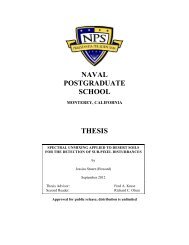October 2000 Newsletter - Naval Postgraduate School
October 2000 Newsletter - Naval Postgraduate School
October 2000 Newsletter - Naval Postgraduate School
You also want an ePaper? Increase the reach of your titles
YUMPU automatically turns print PDFs into web optimized ePapers that Google loves.
MISSILE DEFENSE RESEARCH, continued from page 1<br />
applied network centric operational principles to the Commander,<br />
Sixth Fleet (COMSIXTHFLT) critical operational<br />
issues. This included building on<br />
lessons learned from Operation<br />
Allied Force and previous battle<br />
experiments. FBE-G featured a<br />
decentralized command and<br />
control architecture and focused<br />
on the protection of time critical<br />
targets (TCT) and theater air and<br />
missile defense (TAMD), including<br />
TBMD.<br />
Cueing Architecture for <strong>Naval</strong><br />
Theater Ballistic Missile Defense<br />
Program<br />
RADIANT GOLD is the name<br />
for an umbrella research and<br />
development program under the<br />
auspices of the Navy’s Tactical<br />
Exploitation of National Capabilities<br />
(TENCAP) Office<br />
(OPNAV N632). One of the<br />
many projects under this program is a concept to deliver a<br />
space-based cue to the warfighter. The proposed concept is to<br />
have the ability to deliver a processed cue from sensor to<br />
shooter through a communications network – thereby<br />
increasing the effectiveness of the overall TBMD engagement.<br />
The dynamic nature of the TBM threat requires rapid<br />
dissemination of TBM launch detection and the earliest<br />
possible engagement by a TBMD system. RADIANT<br />
GOLD disseminates the cue through the most effective<br />
means by taking into account the communication capabilities<br />
and limitations of current surface combatants and the limited<br />
bandwidth available in military satellite communications.<br />
There are several R&D concepts in RADIANT GOLD.<br />
First, RADIANT GOLD is seeking out methods and equipment<br />
that can improve TBM situation awareness for theater<br />
commanders. This can improve operational decisions<br />
regarding appropriate passive and active defensive measures<br />
and allow the possibility for rapid transition to attack operations<br />
for counterstrike. Secondly, RADIANT GOLD is<br />
developing methods to cue AEGIS ships of possible TBM<br />
events. The use of a cue offers the possibility of a boost/<br />
ascent phase detection of a TBM and may lead to an earlier<br />
missile engagement. The RADIANT GOLD project is<br />
RESEARCH OVERVIEW<br />
The Assistant Chief of <strong>Naval</strong> Operations<br />
(ACNO) for Missile Defense is<br />
a newly formed staff function to<br />
provide oversight of all policy,<br />
planning, budgeting, funding, requirements<br />
definition, test and<br />
evaluation, deployment, training,<br />
operational doctrine, tactics and<br />
employment of <strong>Naval</strong> missile defense<br />
systems, including area and<br />
theater-wide theater ballistic missile<br />
defense (TBMD) as well as overland<br />
cruise missile defense. The ACNO<br />
for Missile Defense coordinates all<br />
missile defense-related programs<br />
and initiatives throughout the Navy.<br />
currently exploring a method, which can satisfy both R&D<br />
concepts, by utilizing data derived from a Joint Tactical<br />
Ground Station (JTAGS)<br />
ashore. This data can be<br />
forwarded to a remote JTAGS<br />
(RJTAGS) afloat, instead of<br />
waiting for TDDS or TIBS<br />
missile alert broadcasts.<br />
As a result of previous experimentation<br />
of RADIANT<br />
GOLD in theater in August of<br />
1999 aboard the Sixth Fleet’s<br />
flagship, COMSIXTHFLT<br />
requested that the Navy’s<br />
TENCAP office demonstrate<br />
the RJTAGS on an operational<br />
surface combatant at sea in<br />
conjunction with FBE-G. To<br />
this end, TENCAP developed a<br />
demonstration plan of RADI-<br />
ANT GOLD’s capabilities<br />
aboard both the flagship, USS<br />
LaSalle (AGF-3), and the USS<br />
Mahan (DDG 72). Each unit was outfitted with an RJTAGS<br />
and utilized JBS or EHF communications respectively to<br />
receive JTAGS data.<br />
Navy TENCAP established two RADIANT GOLD<br />
demonstration objectives within the overall FBE-G objectives.<br />
The first objective focused on support to the JTF<br />
commander’s situational awareness for attack operations and<br />
local warning requirements for passive defense. This was to<br />
be accomplished by providing national sensor data ashore by a<br />
JTAGS to an afloat RJTAGS. The second objective was to<br />
provide the same sensor data processed ashore by JTAGS to<br />
an AEGIS ship with an active defense mission.<br />
RADIANT GOLD had a successful demonstration while<br />
participating in FBE-G. All operational and analytical<br />
objectives were met and some insight was gained by<br />
TENCAP on the utility of their program. The concept<br />
successfully proved that it could send data for not only passive<br />
defense, but also active defense and attack operations to users<br />
at sea. LT Christopher Atkinson, USN, working with Chair<br />
Professors Alan Ross and Charlie Racoosin of the Space<br />
Systems Academic Group, explored the RADIANT GOLD<br />
concept at the system level and examined it against other<br />
--continued on page 3<br />
NPS Research page 2<br />
<strong>October</strong> <strong>2000</strong>
















